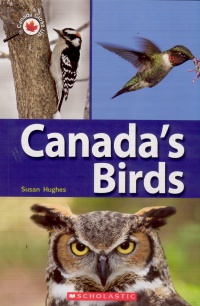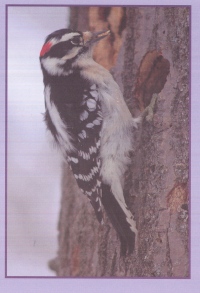| ________________
CM . . .
. Volume XVII Number 6. . . .October 8, 2010 
 |
Canada's Birds. (Canada Close Up).
Susan Hughes.
Toronto, ON: Scholastic Canada, 2010.
52 pp., pbk., $6.99.
ISBN 978-1-4431-0001-4.
Subject Heading:
Birds-Canada-Juvenile literature.
Grades 1-4 / Ages 6-9.
Review by Renée Englot.
*** /4
|
| |
|

excerpt:
What is the first thing you notice about this owl? Is it its horns?
Despite the owl's name, what you see sticking up from its head are not horns. And no, they are not ears, either! The ears are slits on each side of the owl's head.
The "horns" are actually tufts of feathers. No one knows for sure what their purpose is. Maybe the owl uses them to communicate: tufts flat when it's relaxed, and tufts up when it senses danger.
The great horned owl can be found throughout Canada, except in the very far north. It is one of the most common large birds of prey in this country. How large is it? More than one metre from wing tip to wing tip—about the length of a kid's hockey stick.
Did you know that osprey chicks need a kilogram of fish a day each, or that downy woodpeckers at the age of three weeks must be fed every three to four minutes, or that great horned owls are one of the few creatures that will hunt skunks? After reading Canada's Birds, I do. I also know that when a male warbler is trying to woo a female, he may sing up to three thousand songs in one day. The book is full of fascinating facts about Canadian birds.
 Covered in this book are black-capped chickadees, great horned owls, downy woodpeckers, killdeer, ruby-throated hummingbirds, northern shovelers, osprey, ruffed grouse, yellow warblers, and ravens. Each bird comprises its own chapter. Most chapters cover the size of the bird. Size descriptions are done by comparison which I believe will give children a better sense of the size of the bird than would measurements. For example, a downy woodpecker is about the length of a pen, and a female ruby-throated hummingbird weighs as much (or should I say as little) as a nickel. All of the chapters also cover feeding habits, nest building, eggs and life with young birds. Most chapters deal with the bird's adaptations for winter. Where the bird can be found in Canada is covered inconsistently. A helpful addition would have been the inclusion of small graphic with a Canadian map with colour to illustrate each bird's habitat. Covered in this book are black-capped chickadees, great horned owls, downy woodpeckers, killdeer, ruby-throated hummingbirds, northern shovelers, osprey, ruffed grouse, yellow warblers, and ravens. Each bird comprises its own chapter. Most chapters cover the size of the bird. Size descriptions are done by comparison which I believe will give children a better sense of the size of the bird than would measurements. For example, a downy woodpecker is about the length of a pen, and a female ruby-throated hummingbird weighs as much (or should I say as little) as a nickel. All of the chapters also cover feeding habits, nest building, eggs and life with young birds. Most chapters deal with the bird's adaptations for winter. Where the bird can be found in Canada is covered inconsistently. A helpful addition would have been the inclusion of small graphic with a Canadian map with colour to illustrate each bird's habitat.
Not only would these maps have provided additional information, but they would have also broken up some fairly text heavy layouts. On many of the two-page spreads, there's only a single photograph, some only covering one-eighth of the spread. Despite the reasonably large font, this amount of text might seem daunting to beginning readers. The photographs that are included are bright, attractive and focused on images which support the text.
One of the more appealing features of the book is the colour coding of the chapters. Each chapter has its own colour of page. This feature certainly makes finding the next chapter very easy. The lack of an index and of bolded vocabulary are slight drawbacks but do not greatly detract from the book.
Canada's Birds is part of the "Canada Close Up" series that includes books about the animals found in various regions of Canada, bugs, the provinces and territories, rocks and minerals, festivals, natural wonders, sports, and weather, all in Canada, of course.
Recommended
Renée Englot, a former junior high school teacher, now works as a professional storyteller in school settings. She holds a Master of Arts in Children's Literature.

To comment
on this title or this review, send mail to cm@umanitoba.ca.
Copyright © the Manitoba Library Association. Reproduction for personal
use is permitted only if this copyright notice is maintained. Any
other reproduction is prohibited without permission.
NEXT REVIEW |
TABLE OF CONTENTS FOR THIS ISSUE
- October 8, 2010.
AUTHORS |
TITLES |
MEDIA REVIEWS |
PROFILES |
BACK ISSUES |
SEARCH |
CMARCHIVE |
HOME |

 Covered in this book are black-capped chickadees, great horned owls, downy woodpeckers, killdeer, ruby-throated hummingbirds, northern shovelers, osprey, ruffed grouse, yellow warblers, and ravens. Each bird comprises its own chapter. Most chapters cover the size of the bird. Size descriptions are done by comparison which I believe will give children a better sense of the size of the bird than would measurements. For example, a downy woodpecker is about the length of a pen, and a female ruby-throated hummingbird weighs as much (or should I say as little) as a nickel. All of the chapters also cover feeding habits, nest building, eggs and life with young birds. Most chapters deal with the bird's adaptations for winter. Where the bird can be found in Canada is covered inconsistently. A helpful addition would have been the inclusion of small graphic with a Canadian map with colour to illustrate each bird's habitat.
Covered in this book are black-capped chickadees, great horned owls, downy woodpeckers, killdeer, ruby-throated hummingbirds, northern shovelers, osprey, ruffed grouse, yellow warblers, and ravens. Each bird comprises its own chapter. Most chapters cover the size of the bird. Size descriptions are done by comparison which I believe will give children a better sense of the size of the bird than would measurements. For example, a downy woodpecker is about the length of a pen, and a female ruby-throated hummingbird weighs as much (or should I say as little) as a nickel. All of the chapters also cover feeding habits, nest building, eggs and life with young birds. Most chapters deal with the bird's adaptations for winter. Where the bird can be found in Canada is covered inconsistently. A helpful addition would have been the inclusion of small graphic with a Canadian map with colour to illustrate each bird's habitat.